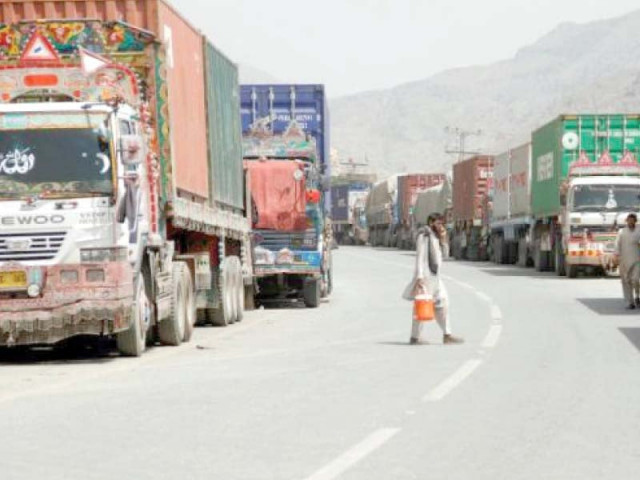Afghanistan-bound: 15,000 containers stuck in Pakistan
Cargo held up at ports and roads due to administrative hiccups, mismanagement

About 15,000 Afghanistan-bound shipping containers, which are more than double the normal number, have been stuck at Pakistan’s seaport en route to their final destination due to administrative hiccups and mismanagement on part of the customs authorities.
The mishandling of Afghanistan-bound cargo has increased the cost of doing business for traders and transporters on the one hand and could adversely affect the already sinking exports on the other hand, background discussions with all the stakeholders revealed.
Every stakeholder involved in the chain, the Federal Board of Revenue (FBR), the transit trade cargo tracking company and the terminal operator - National Logistics Cell (NLC), put the responsibility on others. However, the sufferers are Pakistani exporters, Afghanistan’s importers and transporters.
The closure of Pak-Afghan border during peak time of Covid-19 and subsequent decision by the FBR to ensure 100% scanning of Afghan cargo led to a situation where about 15,000 shipping containers have been stuck, said an official of TPL Trakker company.
These include about 3,500 containers en route to their destination, which can be seen standing around Peshawar city and Chaman and Torkham border posts.
Illegal checking points before the border posts also aggravated the situation, which FBR officials claimed were dismantled last week.
In April this year, the director general of transit trade of the FBR issued an office order about the handling of Afghan cargo, which for many became the root cause for the whole mess. The FBR has made mandatory 100% scanning of containers, though it lacks the facilities, which has blocked the containers at ports and terminals at Torkham and Chaman.
Despite repeated attempts, neither FBR Acting Chairman Javed Ghani nor FBR Member Customs Tariq Huda responded to the question about why the FBR suddenly increased the scanning limit from 10% to 100%.
A TPL Trakker official said prior to Covid-19, the tracking project was being run with an inventory which was sufficient to track up to 12,000 containers a month. The average time taken by containers to reach Afghanistan was six to seven days.
After the closure of Pak-Afghan border due to Covid-19, no containers were released from Pakistani ports and clearances at the border were also stopped. This led to a backlog of containers at ports in Karachi.
Implementation of standard operating procedures (SOPs) began when the borders were reopened and the SOPs related to clearance of containers at Torkham and Chaman were updated by moving from 10% to 100% scanning of containers, according to the company official.
He said this increased trip time from average six to seven days prior to Covid-19 to 20-25 days post-Covid-19 due to slowdown in clearances at the border exit points (Torkham and Chaman). This increased the number of containers en route to Afghanistan due to the slow clearance at exit points and the number of such containers more than doubled, he added.
The decision to implement 100% scanning of containers without increasing the scanning capacity at Torkham and Chaman has choked the borders with containers waiting outside the exit points as there is no parking space left inside the exit points, said the tracking company official. A February 2014 notification of the FBR says 100% scanning of consignments will be “subject to availability of requisite infrastructure”.
The notification further stated that provisions relating to weighing, scanning and tracking and monitoring of vehicles and containers shall become operative once infrastructure and facilities in this regard are made available and after the same is notified by the FBR.
NLC version
NLC, which operates the terminal, denied that its facilities were not sufficient to handle the cargo.
NLC has installed a total of three scanners at Torkham. The allegation about a lack of scanning capacity is totally unfounded as the machines scan 1,200 to 1,400 vehicles per day, according to an NLC spokesman.
He said about 800 vehicles cross the border daily and the same number of vehicles is being scanned by NLC. “The NLC’s role is restricted to scanning and weighing of vehicles inside the border terminal premises and has no role in border crossing of vehicles,” according to the spokesman.
The spokesman said due to Covid-19 all land and air routes were closed, however, shipping lines remained open due to which the containers kept coming to the seaport. “Resultantly, containers piled up inside Pakistan,” he added.
The tracking company official said the company doubled tracker inventory but due to slow clearance at the border exit points, the number of en route containers increased from 1,500 prior to Covid-19 to 3,200-3,500 at any given point in time. Despite increased supply of trackers, the containers are now stationed along Pakistan’s highways on the Torkham/Chaman route due to the slow pace of border clearance, he added.
Port authorities have also been imposing fines on importers due to delay in clearance of their consignments. This was also a major concern of Afghan transporters as demurrage charges are being levied on them by port operators due to containers stationed inside the ports.
Last month, Frontier Customs Agency Association President Ziaul Haq Sarhadi said following the directives of the FBR for 100% examination of transit trade containers at Karachi Port and additional checking of goods trucks at Torkham border slowed down Pakistan’s mutual and transit trade with Afghanistan.
Published in The Express Tribune, September 8th, 2020.
Like Business on Facebook, follow @TribuneBiz on Twitter to stay informed and join in the conversation.

















COMMENTS
Comments are moderated and generally will be posted if they are on-topic and not abusive.
For more information, please see our Comments FAQ